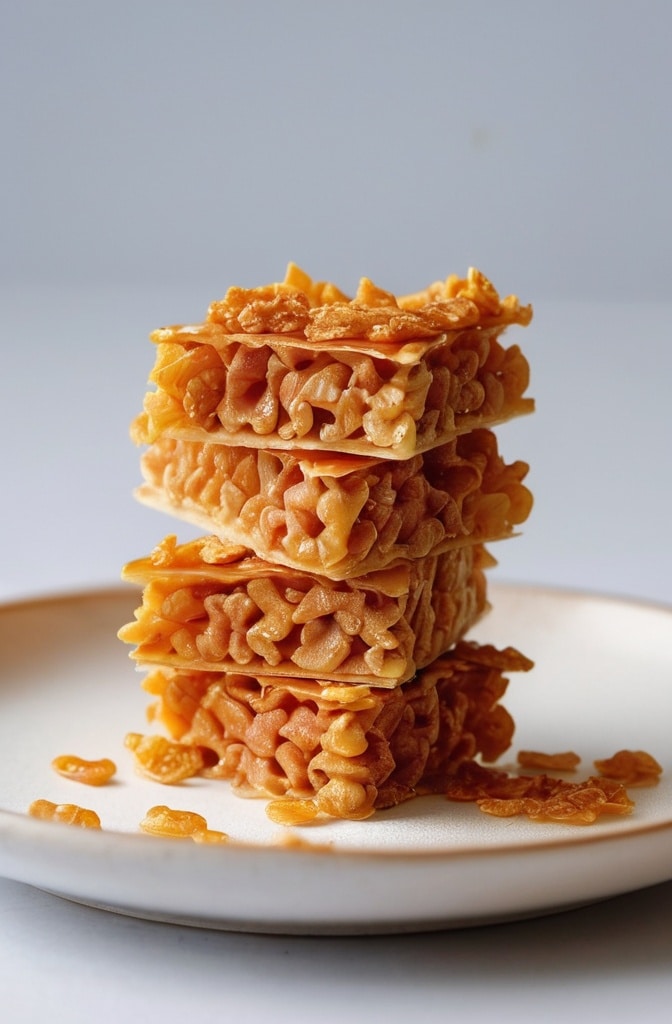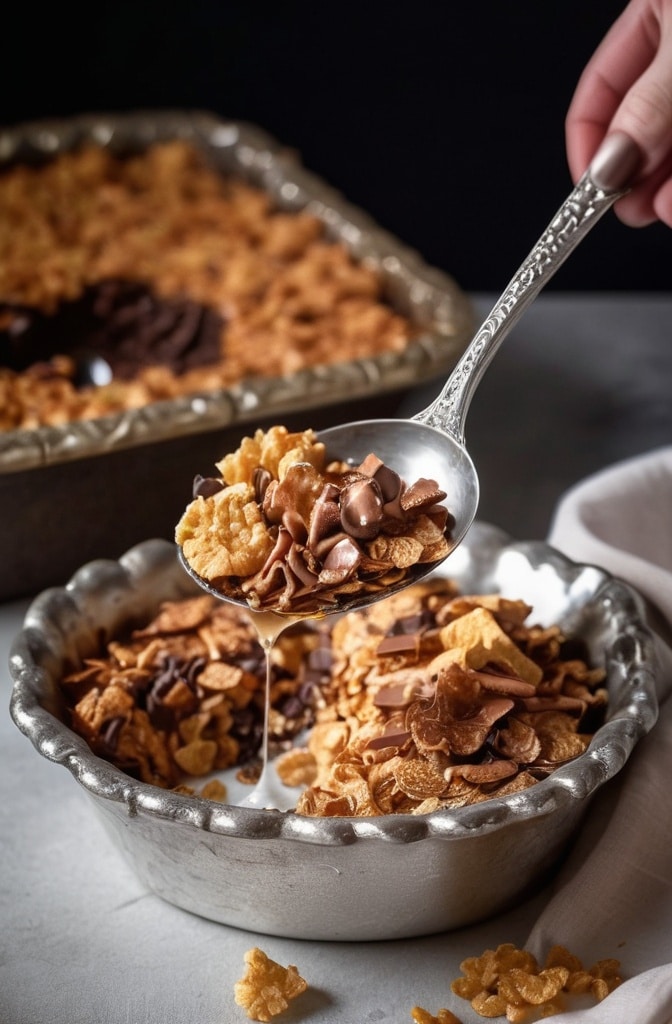I still remember the first time I encountered a proper Cornflake Dessert with Toffee and Chocolate. It was at my grandmother’s kitchen table, where she’d proudly display her latest “experiment” – a glistening slab of toffee-bound cornflakes topped with a decadent layer of chocolate.
That humble Cornflake Dessert with Toffee and Chocolate, balancing on the edge between confection and cereal treat, has stuck with me through culinary school and beyond. Isn’t it fascinating how the simplest combinations often create the most memorable flavors?
The cornflake dessert with toffee and chocolate stands as a testament to culinary ingenuity – transforming breakfast cereal into a sophisticated sweet treat. What makes this dessert truly special is its versatility and the perfect balance of textures: the crunch of cornflakes, the buttery chew of toffee, and the smooth snap of chocolate. This trifecta of textures creates an experience that’s greater than the sum of its parts, and today I’ll share the secrets to creating this remarkable dessert at your own home.
Ingredients & Substitutions
For the Toffee-Cornflake Base:
- 150g unsalted butter (European-style preferred for higher fat content)
- 120g golden syrup or light corn syrup
- 100g light brown sugar, packed
- 1 teaspoon fine sea salt
- 1 teaspoon vanilla extract (or 1 vanilla bean, scraped)
- 200g cornflakes (traditional, not frosted)
For the Chocolate Topping:
- 300g high-quality dark chocolate (60-70% cocoa solids), chopped
- 50g unsalted butter
- 1 tablespoon neutral oil (such as grapeseed)
- Flaky sea salt for finishing (optional)
- 100g chopped nuts (pecans, almonds, or hazelnuts) or 80g toffee bits (optional)
The beauty of this recipe lies in its adaptability. For a dairy-free version, coconut oil works beautifully in place of butter, tho you’ll lose some of that rich dairy flavor. If golden syrup is unavailable, honey makes an excellent substitute, adding a floral note that pairs wonderfully with the chocolate. For those avoiding refined sugar, coconut sugar can replace brown sugar, lending a deeper caramel flavor to the final product.
When selecting cornflakes, opt for a traditional, unflavored variety. The thickness and crunch of cornflakes matter enormously – bargain brands often contain more air and less corn, resulting in a soggier base. Trust me on this one; I’ve made this mistake in front of a kitchen full of culinary students!
Step-by-Step Instructions

Preparing the Toffee-Cornflake Base:
1. Prepare your workspace Line a 9×13-inch baking pan with parchment paper, leaving some overhang for easy removal later. Ensure all ingredients are measured and ready – this toffee mixture waits for no one once it starts cooking.
2. Create the toffee mixture In a large, heavy-bottomed saucepan, combine the butter, golden syrup, and brown sugar over medium-low heat. Stir occasionally until the butter has completely melted. Once melted, increase heat to medium and bring the mixture to a gentle boil. The mixture should bubble steadily but not violently; this isn’t a rapid boil situation. Continue cooking for about 3-4 minutes until the mixture darkens slightly and thickens. A common mistake here is undercooking – you want the sugar properly dissolved and slightly caramelized for that perfect chewy texture.
3. Incorporate the cornflakes Remove the pan from heat and immediately stir in the sea salt and vanilla extract. Working quickly but gently, fold in the cornflakes using a silicone spatula or wooden spoon. Ensure every flake is coated evenly with toffee mixture. The goal is to maintain as much cornflake integrity as possible – you want coated cornflakes, not cornflake dust! This is where quality cornflakes prove their worth, as they’ll hold up better to the folding process.
4. Form the base layer Transfer the coated cornflakes to your prepared baking pan. Using the back of your spatula (slightly dampened to prevent sticking) or your fingertips (lightly oiled), press the mixture firmly into an even layer. Don’t compress it too aggressively – you want to create a solid base without crushing the cornflakes into oblivion. Allow the mixture to cool completely at room temperature, about 30 minutes. For a firmer base, you can refrigerate it for 15 minutes, but no longer or the chocolate may not adhere properly.
Creating the Chocolate Topping:
1. Temper the chocolate In a heatproof bowl set over barely simmering water (ensure the bottom doesn’t touch the water), combine the chopped chocolate with butter and oil. Stir occasionally until about 80% melted, then remove from heat and continue stirring until completely smooth. The addition of a small amount of oil helps create a chocolate layer that cuts cleanly rather than shattering when served – a technique I picked up from a Belgian chocolatier years ago.
2. Apply the chocolate layer Pour the melted chocolate mixture over the cooled cornflake base, using an offset spatula to spread it evenly to the edges. If using optional toppings like chopped nuts or toffee bits, sprinkle them over the chocolate now, gently pressing them into the surface. For an elegant finish, sprinkle with flaky sea salt to contrast with the sweetness.
3. Set the chocolate Allow the dessert to set at room temperature for about 1 hour (longer in warm environments), or refrigerate for 30 minutes until the chocolate is just set but not rock-hard. Over-chilling will cause the chocolate to lose its sheen and may lead to separation from the base when cutting.
4. Portion and serve Using the parchment overhang, lift the entire slab from the pan and transfer to a cutting board. With a sharp knife warmed briefly under hot water (and dried), cut into squares or rectangles. Clean and rewarm the knife between cuts for the cleanest edges. For formal presentation, I’ve found that 1×2-inch rectangles create the most elegant appearance, reminiscent of traditional petit fours.
Cooking Techniques & Science
Understanding the science behind this seemingly simple dessert elevates it from a casual treat to a technical achievement. The toffee formation represents a perfect example of sugar crystallization control – we want some crystallization for texture, but not so much that the toffee becomes grainy. The vanilla and salt are added after cooking for this very reason – salt can affect sugar crystallization if added too early.
The cornflakes serve more than just a textural purpose; their toasted corn flavor undergoes further development through the Maillard reaction when coated with hot toffee. This creates deeper flavor compounds that complement the caramel notes in the toffee. Its why store-bought versions never quite match homemade – they miss this crucial flavor-developing step.

When working with chocolate, proper tempering (even the simplified method described here) ensures that cocoa butter crystallizes in a stable form, providing that satisfying snap and glossy appearance. The small amount of neutral oil helps prevent blooming (that whitish appearance chocolate can develop over time) and maintains the clean cutting properties of the chocolate layer.
One specialized technique worth mastering is the “shimmy” – after pouring the chocolate, gently tap and shake the pan to create a completely level chocolate surface without resorting to excessive spreading, which can lead to streaks or bubbles. Professional pastry chefs use this method to create that mirror-like chocolate finish you see in high-end patisseries.
Serving & Pairing Suggestions
The cornflake toffee dessert achieves its fullest potential when served at just below room temperature – about 65°F (18°C) is ideal. This allows the toffee to maintain its chewy quality while the chocolate remains firm but not brittle. If refrigerated, remove the dessert 15-20 minutes before serving to achieve this optimal temperature balance.
For elegant presentation, consider these professional approaches:
- Cut into precise rectangles and arrange on a slate or marble surface with scattered cocoa nibs
- Serve individual portions atop a small pool of crème anglaise with a single raspberry for color contrast
- For a deconstructed approach, crush portions and layer with whipped mascarpone in clear glasses for a parfait-style presentation
This dessert pairs beautifully with beverages that can cut through its richness. A medium-bodied coffee with caramel notes makes an excellent companion, as does a tawny port or cream sherry. For a non-alcoholic option, try a malted milk or spiced chai tea – both echo the comforting, nostalgic qualities of the cornflakes while balancing the sweet toffee.
For complete menu planning, this dessert follows hearty main courses beautifully – its combination of textures and flavors is particularly effective after dishes that feature umami-rich components like mushrooms or aged cheeses. The contrast creates what I call a “palate reset” – revitalizing taste buds and creating a distinct sensory experience.
Advanced Variations
While the classic version shines on its own merits, professional adaptations can create signature versions of this versatile dessert:
Seasonal Spice Variation: Infuse the toffee with warming spices like cinnamon, cardamom, and a touch of black pepper. This adaptation works beautifully in autumn and winter, especially when topped with crystalized ginger pieces.
Adult Dessert Version: Add 2 tablespoons of bourbon or rum to the toffee mixture just before adding the cornflakes. The alcohol will cook off, leaving behind complex flavor compounds that elevate the entire dessert. Consider using a chocolate with orange notes for this variation.
Modern Patisserie Approach: Create individual desserts by pressing the cornflake mixture into small ring molds. Once set, top with chocolate, then finish with gold leaf and a miniature quenelle of crème fraîche for a show-stopping plated dessert.
For those with access to specialized ingredients, replacing traditional cornflakes with heritage grain flakes (like ancient Egyptian Kamut) creates an earthy, nutty variation with greater nutritional depth and an interesting talking point for diners.
Conclusion
The cornflake dessert with toffee and chocolate represents a perfect intersection of nostalgic comfort and culinary technique. It’s accessibility makes it approachable, while its technical elements offer room for mastery and personalization. The key to elevating this dessert lies in understanding the interactions between its components – the structural integrity of the cornflakes, the crystalline structure of the toffee, and the temper of the chocolate all contribute to the final experience.
Whether prepared as a casual family treat or refined for elegant entertaining, this dessert’s versatility makes it a valuable addition to any culinary repertoire. I’ve personally witnessed this humble creation earn its place alongside much more complex patisserie on upscale dessert menus, proving that sophistication doesn’t always require complexity.
The most important advice I can offer? Approach this recipe with both precision and joy. The technical aspects matter, but so does the simple pleasure of creating something delicious that brings people together. After all, isn’t that the ultimate purpose of our craft?
Frequently Asked Questions
Why did my chocolate layer crack when I cut the dessert?
Chocolate cracking typically occurs when its been refrigerated too long or is too cold when cut. Allow the dessert to warm slightly before cutting, and always use a knife warmed under hot water and dried between cuts. The addition of a small amount of neutral oil to the chocolate also helps prevent this issue.
Can I make this dessert ahead of time? How should I store it?
Absolutely! This dessert actually benefits from being made 8-12 hours ahead, allowing flavors to meld. Store at cool room temperature (below 70°F/21°C) covered with parchment rather than plastic wrap to prevent condensation. If storing longer than 24 hours, refrigerate but bring back to room temperature before serving.
My toffee mixture seems grainy rather than smooth. What went wrong?
Grainy toffee usually results from sugar crystallization. To prevent this, avoid stirring too vigorously once the mixture begins to boil, make sure all sugar crystals are dissolved before boiling, and consider adding a teaspoon of lemon juice or corn syrup to the initial mixture, as acid helps prevent crystallization.
Can I freeze this dessert for longer storage?
While possible, freezing isn’t ideal for this particular dessert as the varying moisture contents of the layers respond differently to freezing and thawing. The cornflakes may become soggy and the chocolate may develop condensation issues. If you must freeze it, wrap individual portions tightly in parchment and then plastic wrap, and thaw unwrapped at room temperature.
Is there a way to make this dessert less sweet without compromising texture?
Yes! Use a darker chocolate (75-85% cocoa solids) for the top layer and add an extra pinch of salt to the toffee mixture. Additionally, incorporating 1-2 tablespoons of cocoa powder into the toffee mixture adds depth and bitterness that balances the sweetness without affecting the crucial textural elements.

